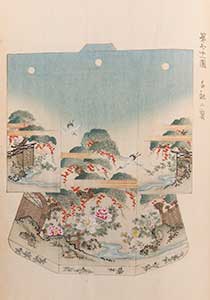The long, rectangular shape of the Japanese kimono serves as a canvas that has inspired artists and fashion designers for centuries. A new rare book exhibition at the

Chicago Botanic Garden explores the history of
kimono design through hand-printed books of kimono patterns. The display, Moku Hanga: the Art of Japanese Woodblock Printing, runs from May 16 through August 10, 2014, in the Lenhardt Library.
The elegant hand-inked and hand-bound books first appeared in 1666, and served as reference works for kimono designers and makers centered in Kyoto.
Filled with images of flowers, grasses, water, trees and wildlife, the works reflect the profound influence of the natural world on the arts of Japan. The pattern books, created by some of Japan’s most famous artists and also by complete unknowns, became an established genre closely following changing tastes. By the early 1700s, fashion called for flamboyant patterns sweeping the length of the kimono, and some incorporated symbols of the samurai.
Featured in the Moku Hanga exhibition is a lavish sample book published in 1902 by Yaichiro Ichida for the company Ichida Shoten, a high-end kimono draper. The page opens to a gorgeous woodblock print of peonies that would have decorated the interior of a haori, a kimono jacke
t. Also on display is the first major work of Sekka Kamisaka, considered to be one of the greatest Japanese designers of the twentieth century. The volume, Chigusa: All Kinds of Things, published in 1903, opens to “Snowy Plu
m under the Moonlight” and “Willow and Cherry Blossoms.”
A 1905 book by Tamahiro Shimomura contains images from the first twentieth century fashion craze in Japan, the revival of the Genroku era, the golden age of Japanese culture and the byword for elegance, glamour and sophistication. Art nouveau and art deco sensibilities also resonated with Japanese artists, who incorporated elements of the western art movement into their work. Early twentieth-century volumes by Korin Furuya, an enormously creative and influential artist, present multiple variations of single themes. His finest,Shasei Soka Moyo, Patterns of Plants and Flowers, shows a special affinity for the natural world.
A library talk on Moku Hanga will take place at 2 p.m. on Sunday, June 29.
Moku Hanga: the Art of Japanese Woodblock Printing is generously supported by the Harriet Kay and Harold R. Burnstein Fund for Exhibits.